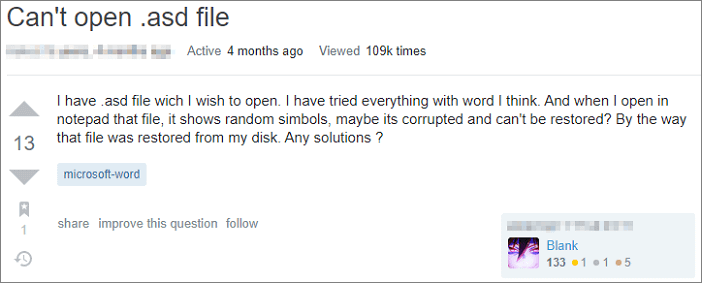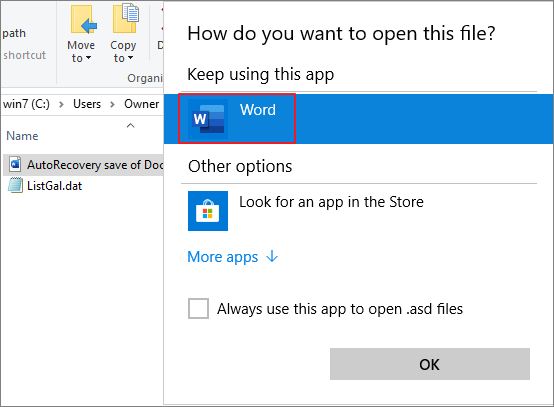How to Open ASD File and Recover Lost Word Document Easily
Quick Navigation: 4 Ways to Open ASD File
If you don't know how to open ASD file in Word 2019/2016/2010/2007, read this article and learn three methods for ASD file recovery.
| Workable Solutions | Step-by-step Troubleshooting |
|---|---|
| Fix 1. Open ASD File via Recover Unsaved Documents Option | Use the AutoRecover function to open the Word ASD file. Open Word > "File" > "Open" > "Recent" > Click "Recover Unsaved Document"...Full steps |
| Fix 2. Open ASD File from Manage Document in Word | This is another simple way to open ASD file. Open "Word" > "File" > "Info" > "Manage Document" > "Recover Recent Unsaved Documents"...Full steps |
| Fix 3. Open ASD File in File Explorer | Open File Explorer, input the ASD file path: C:\Users\UserName\AppData\Roaming\Microsoft\Word\, look for ASD files...Full steps |
| Fix 4. Recover Lost ASD File with Data Recovery Software | If you can't find the ASD file or lost Word document, you can use Qiling file recovery software to scan your PC your recover the ASD file. Besides, it can repair corrupted Word document automatically...Full steps |
User Case: Can't Open .asd Files, How to Open ASD Files
"I have .asd file which I wish to open. I have tried everything with the word I think. And when I open in notepad that file, it shows random symbols, maybe it's corrupted and can't be restored? By the way, that file was restored from my disk. Any solutions?"

What Is an ASD File Word
A .asd file contains a snapshot or backup copy of the currently open Word document created by Microsoft Word's AutoRecover tool. It is usually used to recover unsaved Word files due to a power outage, crash, or system failure.
In general, the .asd files can be opened with Microsoft Word 2010 in Microsoft Windows-based Systems. But sometimes, you might fail to open it like in the example above; Word may say that the data is unsupported and cannot open it. This guide will show you three working ways to open an ASD file and recover the .asd files with ease.
Also read: Word 2010/2013/2016 Keeps Crashing When Saving
Method 1. Open ASD Files via Recover Unsaved Documents
Word searches for AutoRecover files each time it starts. Then, it displays any data found in the Document Recovery task pane. You can find and open ASD files with the Recover Unsaved Documents feature. Here are the steps to locate and open ASD files in Microsoft Word:
Step 1. Open Word and click on "File" > "Open" > "Recent".
Step 2. Look towards the bottom of the screen, and click "Recover Unsaved Documents".

Step 3. A pop-up window will show the ASD file contained in the UnsavedFiles Folder. Select the ASD file you need, then click "Open" > "Save As" to convert the ASD file to Word.

Also read: How to Recover Unsaved Word Document in Windows 10
Method 2. Open ASD Files from Manage Document Option in Word
Another way to find and open ASD files is to use the Manage Document feature in Microsoft Word.
Step 1. In MS Word, click the "File" > "Info" tab in the upper left corner.
Step 2. Click "Manage Document" and select "Recover Unsaved Documents" from the drop-down list.
Step 3. Also, on the Open Window, choose the ASD file you want and click "Open" to recover the ASD file.

Method 3. Open ASD File in File Explorer
Microsoft Office Word periodically backs up a document as you work on the file as long as you enabled the AutoRecover feature. The ASD files located in the directories given below:
- On Windows 11/10/8/7/Vista: C:\Users\UserName\AppData\Roaming\Microsoft\Word\
- On Windows XP: C:\Users\UserName\Application Data\Microsoft\Word\
You can copy the file path in File Explorer. Then, look for and open ASD files in File Explorer.
Step 1. Press Win + E keys to open File Explorer. Copy the file path and find the ASD file on your computer.

Step 2. Right-click on the .asd file, select "Open With..." and click "OK".

Step 3. Open the .asd file with the Word option. Click "Save As" to convert ASD files to Word.
Method 4. Recover Lost ASD or Word Files with Data Recovery Software
Microsoft ASD files or Word documents can be lost in many cases, such as accidental deletion, storage device formatting/damage, virus attack, lost partition, etc. When this happens, you can't recover the ASD or Word files using the AutoRecover feature, as that can only restore unsaved Word documents and not the lost or deleted files.
Then, how do you recover the deleted or lost Word document? Don't be discouraged; you have Deep Data Recovery, a top-notch data recovery tool, to help you out.
Robust Helper - Deep Data Recovery
- Recover lost or deleted files, documents, photos, audio, music, and emails effectively
- Restore deleted files from USB flash drive, emptied recycle bin, memory card, flash drive, digital camera, and camcorders
- Support data recovery for sudden deletion, formatting, hard drive corruption, virus attack, and system crash under different situations
Go heard and download and use Qiling document recovery program to recover ASD files and Word documents in three steps.
Step 1. Select file types and click "Next" to start
Launch Deep Data Recovery. Select file types and click "Next" to start.

Step 2. Choose the Word file location
Choose the drive or a specific folder and click the "Scan" button.

Step 3. Locate your Word files
The software will start immediately scanning all lost data on the selected drive. After the scan, click the "Documents" option in the left panel. Choose "Word" from the category bar. Then, click "Preview".

Step 4. Recover Word files
After previewing the lost Word files, select the desired Word files and click "Recover". Then, select a folder to store the Word files.
Bonus Tip: How to Convert ASD Files to Word
When you're working on a document, Word automatically creates backup files in case the program crashes. The file extension is .asd. To convert an ASD file to .doc, you can follow the steps below:
Step 1. Open Microsoft Word. Click the "File" menu, then click "Open."
Step 2. Go to your username folder. You can find it in the drop-down menu at the top of the window.
Step 3. Double-click the "AppData" sub-folder inside your user folder. Double-click the "Roaming" folder, then select the "Microsoft" folder. Open the "Word" folder.
Step 4. Click the drop-down menu at the bottom of the window labeled "Files of Type," then click "All Files." Double-click the ASD file to open it.
Step 5. Click the "File" menu, then click "Save As." Under "Save as Type," select the DOC file format. Select a location for the converted file, then type in a name and click "Save."

Final Thoughts
The AutoRecover feature in Word makes an emergency backup to help recover and open ASD file/Word document when an error occurs. Some errors can interfere with auto-recovery functionality. But, if you lost your backup - ASD files, you can use Qiling data recovery software to get back Word files with simple steps.
ASD File Recovery Frequently Asked Questions
You have learned about three effective ways on how to open an ASD file in Windows 10/8/7. If you have other problems, read the questions and answers below.
1. Where are ASD files saved?
- In Windows 7 and Vista, the file is stored in the C:\Users\username\AppData\Roaming\Microsoft\Word\ (username will be replaced by the author's username).
- In Windows XP, the file is stored in the C:\Documents and Settings\username\Application Data\Microsoft\Word \ (username will be replaced by the author's username).
- In Mac OS X, the file is stored in the C:\/Users/username/Documents/Microsoft User Data/Office version AutoRecovery/Autorecovery save of filename
2. Can you delete the .asd files, do they store any info?
The .asd files keep metadata for Live to reference when importing tracks to allow for quicker export, especially across multiple projects and sessions. You can delete them safely, the only drawback is that any audio file used in a project will have to be rescanned when loading the project again, which can be time-consuming if you have a large amount in a project.
3. Where Does Excel Store Temp Files?
- Windows 10: C:\Users\AppData\Local\Microsoft\Office\UnsavedFiles
- Windows 8/7/Vista: C:\Users\UserName\AppData\Local\Microsoft\Office\UnsavedFiles
- Windows XP: C:\Documents and Settings\UserName\Local Settings\Application Data\Microsoft\Office\UnsavedFiles
4. How do I open an ASD file in Word 2010?
To open a .asd file in Word 2010:
- 1. On the File menu, select Open.
- 2. In the Files of type list (All Word Documents), select All Files.
- 3. Select the .asd file that you found, and then select Open.
Related Articles
- How to Recover Files from Folder Lock Without Password Step-by-Step
- How to Recover Unsaved Word Document After Computer Restarts/Shutdown
- How to Recover Permanently Deleted Emails from Gmail Account
- How to Recover Deleted Windows.old Folder in Windows 11/10